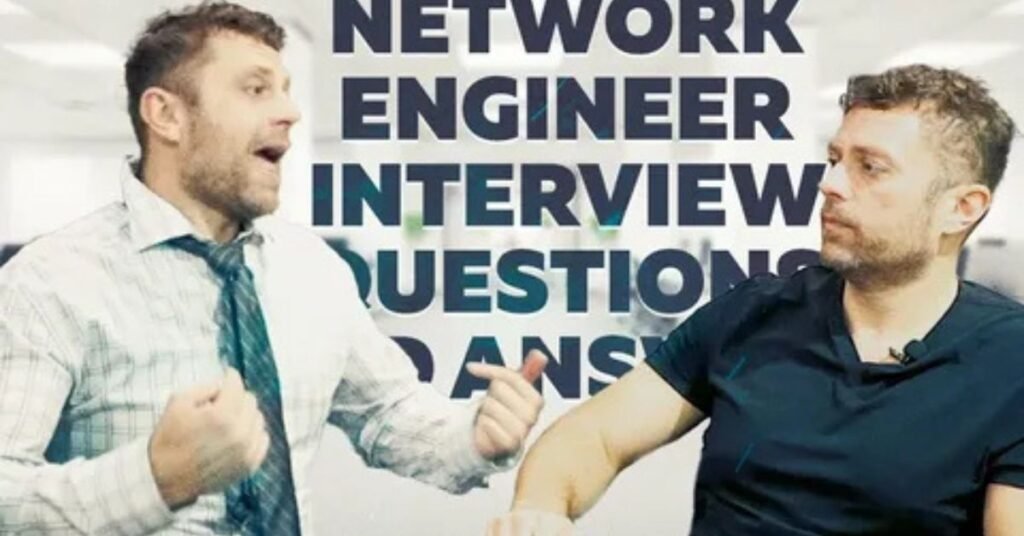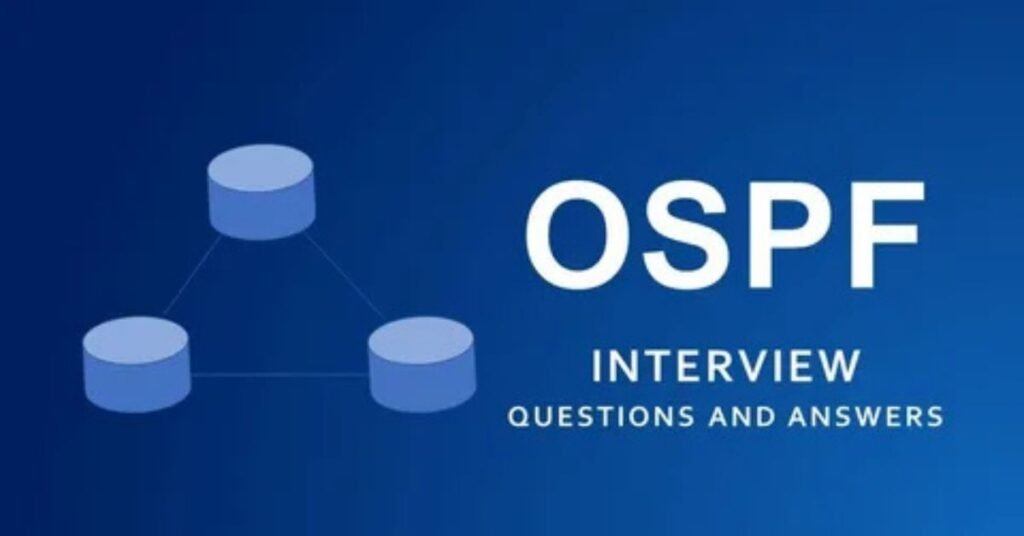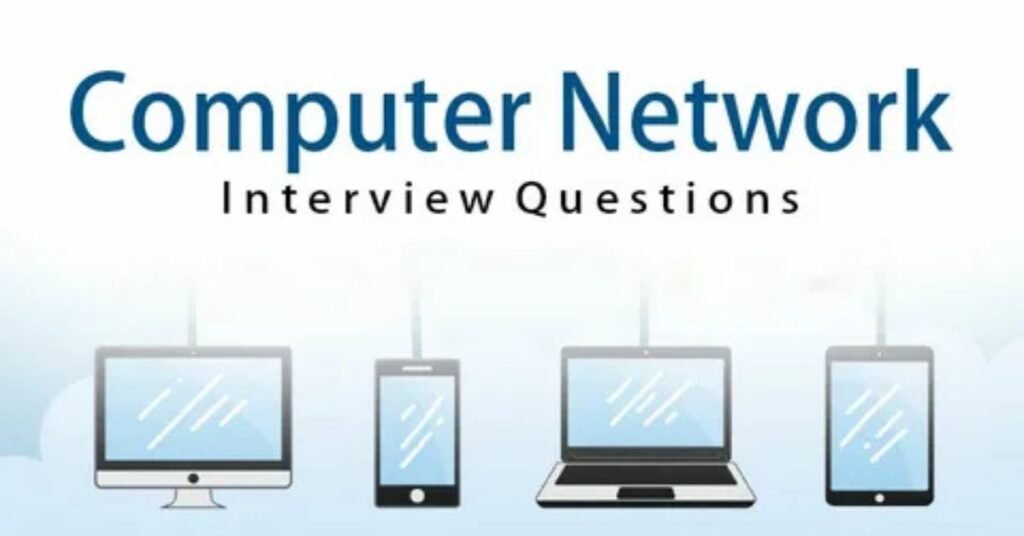Introduction
Network Engineers design, implement, and manage computer networks. They ensure that systems run smoothly and securely. Their work involves configuring hardware, maintaining network performance, and solving technical issues.
Are you preparing for a Network Engineer interview? Having the right answers and questions can boost your self-confidence. This guide covers the latest questions interviewers ask. It will help you understand what to expect and how to respond clearly.
In this article, you will find 47 updated Network Engineer interview questions with detailed answers. These questions cover key topics like networking protocols, troubleshooting, and security. Whether you are a beginner or an experienced professional, this guide will prepare you for success.
List of Top Network Engineer Interview Questions
Interviewers often ask about your understanding of fundamental networking concepts. They want you to explain IP addressing, subnetting, and routing protocols. They may ask you to describe how DNS works or troubleshoot common network problems. You should prepare to discuss your experience with network security and firewalls. They might also ask about your familiarity with cloud networking and virtualization.
Expect questions about specific networking technologies and tools. They may want to know your experience with Cisco, Juniper, or other vendors. They might ask about your knowledge of network monitoring and performance analysis. You should be ready to discuss your problem-solving skills and how you handle network outages. They will likely ask about your ability to work in a team and communicate technical information effectively.

What is a LAN?
A LAN connects devices in a small area. It lets computers and printers share resources.
What is a WAN?
A WAN connects networks over a large area. It links LANs across cities or countries.
What is a hub?
A hub is a simple networking device. It sends data to all connected devices. It does not filter or manage traffic.
What are switches?
Switches connect devices on a local network. They learn device addresses. They send data only to the intended device. This improves network efficiency. Switches reduce collisions and increase bandwidth. They are more intelligent than hubs.
What is data encapsulation?
Data encapsulation adds headers to data. It wraps data in layers. Each layer adds information. This information helps data travel. It ensures data reaches its destination. It is a key part of network communication.
Describe network topology.
Network topology shows how devices connect. It maps the physical or logical layout. It defines how data flows.
What is a VPN?
A VPN creates a secure connection. It extends a private network. It uses the public internet. It encrypts your internet traffic. It hides your IP address.
What is NAT?
NAT translates IP addresses. It allows private networks to use public IPs. It hides internal IP addresses. It conserves public IP addresses. It helps secure internal networks. It maps multiple private IPs to one public IP.
What is the OSI Physical Layer?
The Physical Layer is the first OSI layer. It defines electrical and physical specifications. It concerns cables and connectors. It transmits raw bit streams. It handles physical connections. It deals with signals and media.
What is a proxy server?
A proxy server acts as an intermediary. It sits between the client and server. It forwards client requests. It can filter web content. It can cache web pages. It improves network performance. It can enhance security. It masks the client’s IP address.
What is the spine network?
A spine network is a two-layer network topology. It uses spine and leaf switches. Leaf switches connect to servers. The spine switches interconnect all leaf switches. It provides high bandwidth and low latency. It is common in data centers. It allows for scalable network designs. It improves east-west traffic flow.
What is a hub-to-hub connection?
A hub-to-hub connection links two or more hubs. It expands a network’s reach. It creates a simple network extension. All devices connected to either hub share the same collision domain. This can lead to network congestion. It is an older networking method. It is often replaced by switches.
What is anonymous FTP?
Anonymous FTP allows users to access files without a specific account. Users log in with “anonymous.” They often use their email as a password. It provides public access to files. Servers allow downloads and sometimes uploads. It is used for sharing software and documents. Security risks exist. It is less common due to web-based downloads.
What is a subnet mask?
A subnet mask separates a network address. It divides the IP address. It defines the network and host portions. It uses a 32-bit number. It works with an IP address. It helps routers direct traffic. It controls the size of a subnet. It determines the number of usable hosts.
What is the maximum length allowed in a UTP cable?
UTP cables have a maximum length of 100 meters. This limit ensures signal integrity. Longer cables can cause signal loss. This affects network performance. Repeaters or switches can extend the network. This keeps signal strength within acceptable limits. This is a standard for Ethernet networks.
How does network topology affect network setup?
Topology dictates how devices connect. It impacts the cable layout. It influences network performance. It affects fault tolerance. Star topology centralizes connections. Bus topology uses a single cable. Mesh topology offers redundancy. Ring topology forms a closed loop. Each topology has pros and cons. It determines ease of expansion. It affects troubleshooting complexity.
What is RIP?
RIP is the Routing Information Protocol. It is a distance-vector routing protocol. It uses hop count as a metric. It updates routing tables periodically. It broadcasts routing information. It is simple to configure. It is an older protocol. It is less efficient for large networks. It can suffer from slow convergence.
What is the importance of carrying out a Fault Tolerance System?
Fault tolerance ensures continuous operation. It prevents single points of failure. It minimizes downtime. It maintains critical services. It uses redundant hardware or software. It allows systems to recover from failures. It improves reliability. It protects against data loss. It keeps businesses running smoothly.
What does 10Base-T mean?
10Base-T specifies Ethernet standards. “10” means 10 Mbps speed. “Base” indicates baseband signaling. “T” signifies twisted-pair cabling. It uses a category 3 or higher UTP cable. It supports up to 100 meters. It is a common Ethernet standard. It is used in local area networks. It is a wired network connection.
When using a router, how would you handle a network?

I would configure the router’s interfaces. I would assign IP addresses and subnet masks. I would set up routing protocols. I would create access control lists. I would monitor network traffic. I would troubleshoot connectivity issues. I would update the router’s firmware. I would ensure network security. I would optimize network performance.
You May Read This: Network Scanning: Processes, Tools, Types, and Advantages
Define the OSI model.
The OSI model is a conceptual framework. It standardizes network communication. It divides network functions into seven layers. Each layer performs a specific task. Data Link, Network, Transport, Session, Presentation, Application, and Physical are among the layers. It helps understand network protocols. It aids in troubleshooting network issues. It promotes interoperability between devices. It simplifies network design and implementation.
What is the difference between Hub vs. Switch vs. Router?
A hub broadcasts data to all devices. A switch forwards data to specific devices. A router connects different networks. A hub operates at the Physical layer. Switches function at the Data Link layer. A router operates at the Network layer. Hubs create collision domains. Switches create collision domains per port. Routers create broadcast domains. Hubs are simple and cheap. Switches are more intelligent and efficient. Routers are complex and manage network traffic.
What does COBIT® (Control Objectives for Information and Related Technologies) refer to?
COBIT® is a framework for IT governance. It helps align IT with business goals. It provides a set of best practices. It focuses on information and technology. It defines control objectives. It supports risk management. It ensures compliance with regulations. It helps organizations manage IT processes. It improves IT performance and efficiency.
Why is putting in place a fault tolerance system important?
Fault tolerance ensures systems keep working. It prevents single points of failure. It minimizes downtime. It protects against data loss. It keeps critical services running. It uses backup hardware or software. It allows systems to recover quickly. It improves overall system reliability. It keeps businesses operational during failures.
How does network topology affect network setup?
Topology defines how devices connect. It dictates cable layout. It impacts network performance. In a star topology, a central hub or switch is utilized. Bus topology uses a single cable. Mesh topology offers redundancy. Ring topology creates a closed loop. Each topology has different costs and complexities. It influences troubleshooting. It affects scalability. It determines network resilience.
How are tunnels used in networking?
Tunnels create secure connections. They encapsulate network traffic. They send data through public networks. They protect data privacy. They bypass network restrictions. They connect private networks. They use protocols like IPsec or GRE. They create VPN connections. They allow secure remote access. They enable data to travel safely.
Explain the significance of Encryption on a network.
Encryption protects data in transit. It scrambles data into an unreadable form. It prevents unauthorized access. It ensures data confidentiality. It secures sensitive information. It protects against eavesdropping. It helps maintain data integrity. It builds trust in network communication. It is essential for online security.
What is multicast routing?
Multicast routing sends data to multiple recipients. It uses a single transmission. It reduces network traffic. It improves efficiency. It targets specific groups.
What is a private IP address?
In a local network setting, a private IP address is used. It is not routable on the internet. It helps conserve public IP addresses. It allows devices to communicate internally. It is defined in specific IP ranges. It enhances network security. Routers translate private IPs to public IPs.
What is the OSI Session Layer?
The Session Layer manages communication sessions. It establishes, maintains, and terminates connections. It controls dialog between applications. It handles session checkpoints. It synchronizes data exchange. It recovers from session disruptions. It ensures orderly data flow.
What are proxy servers, and in what ways do they safeguard computer networks?
Proxy servers act as intermediaries. They sit between clients and the internet. They filter web traffic. They hide internal IP addresses. They cache frequently accessed content. They control access to websites. They block malicious traffic. They improve network performance. They enhance network security. They log network activity. They protect against direct attacks.
What role does the OSI Session Layer serve?
The Session Layer manages communication sessions. It establishes connections. It maintains an ongoing dialog. It terminates sessions when finished. It handles session synchronization. It sets up checkpoints for recovery. It controls data exchange between applications. It ensures proper session management. It helps applications communicate effectively.
What does the profile entail regarding networking concepts?
A network profile defines network settings. It includes IP addresses and subnet masks. It stores connection preferences. It specifies security settings. It controls access permissions. It manages network device configurations. It stores user-specific network data. It simplifies network management. It allows for consistent network settings. It helps automate network configurations.
What is sneakernet?
Sneakernet uses physical media for data transfer. It moves files on storage devices. It bypasses network connections. It relies on manual transport. It is a very old data transfer method. It is used in isolated environments.
What protocols fall under the TCP/IP Internet Layer?
IP (Internet Protocol) is a key protocol. ICMP (Internet Control Message Protocol) reports errors. ARP (Address Resolution Protocol) resolves IP to MAC addresses. IGMP (Internet Group Management Protocol) is responsible for the management of multicast groups. These protocols handle network addressing. They enable data routing.
When it comes to networking, what are rights?
Rights define user permissions. They control access to network resources. They determine what users can do. They include read, write, and execute permissions. They manage access to files and folders. They ensure network security.
What is one fundamental requirement for establishing VLANs?
You need a managed switch. The switch must support VLAN tagging. It needs to understand 802.1Q. You must configure the switch ports. You assign ports to specific VLANs. This isolates network traffic.
When developing a network disaster recovery plan, what are some crucial considerations?
You must identify critical network components. You need to back up configuration files. You should test backups regularly. You must document recovery procedures. You need to establish off-site backups. You must define recovery time objectives.
You should plan for communication during disasters. You should train staff on recovery procedures. You must consider physical security. You need to address data redundancy.
How can a network be protected from DDoS attacks?

You use firewalls and intrusion detection systems. You filter malicious traffic. You implement rate limiting. You use a content delivery network (CDN). You distribute traffic across multiple servers. You monitor network traffic for anomalies.
You keep software and firmware updated. You use DDoS mitigation services. You plan for bandwidth over-provisioning. You train staff to recognize attacks.
Describe how port address translation (PAT) and network address translation (NAT) differ.
NAT translates IP addresses. PAT translates IP addresses and port numbers. One private IP is mapped to one public IP by NAT. PAT maps multiple private IPs to one public IP using different ports. NAT is simpler. PAT is more efficient for conserving public IPs.
NAT usually involves a one-to-one mapping. PAT involves a many-to-one mapping. Both help hide internal network addresses. PAT is a type of NAT.
How does utilizing a network monitoring system (NMS) benefit you?
An NMS provides real-time network visibility. It helps detect network problems quickly. It monitors network performance. It alerts you to potential issues. It helps troubleshoot network outages. It improves network reliability.
It gathers network statistics. It helps plan network upgrades. It reduces downtime. It enhances security monitoring.
What is the Border Gateway Protocol’s (BGP) objective?
BGP routes traffic between autonomous systems (AS). It exchanges routing information. It makes routing decisions. It chooses the best paths. It connects different networks. It handles large-scale routing. It is used on the internet. It ensures reliable data delivery. It is a path-vector protocol.
Explain the concept of Quality of Service (QoS) and how it works.
QoS prioritizes network traffic. It ensures critical applications get bandwidth. It manages network resources. It reduces latency and jitter. It improves voice and video quality. It uses techniques like traffic shaping. It assigns priority levels to traffic.
It marks packets for preferential treatment. Routers and switches implement QoS. It helps maintain a consistent network experience.
Why is network segmentation necessary, and what does it entail?
Network segmentation divides a network into smaller parts. It improves security. It isolates sensitive data. It limits the impact of breaches. It enhances network performance. It reduces broadcast traffic. It simplifies network management.
It controls access to resources. It helps comply with regulations. It improves fault containment. It increases overall network resilience.
What are some common causes of network congestion?
High network traffic causes congestion. Too many devices send data at once. Insufficient bandwidth limits data flow. Faulty network devices slow down traffic. Broadcast storms flood the network. Large file transfers consume bandwidth.
Malware and DDoS attacks overwhelm resources. Inefficient routing leads to bottlenecks. Old or poorly configured hardware causes delays. Software bugs can create excessive traffic. Lack of QoS prioritization exacerbates issues.
What is the difference between IPv4 and IPv6?
IPv4 uses 32-bit addresses. IPv6 uses 128-bit addresses. IPv4 has limited address space. IPv6 has a vast address space. IPv4 uses dotted decimal notation. IPv6 uses a hexadecimal notation. IPv6 supports built-in security features. IPv4 relies on external security.
IPv6 simplifies address configuration. IPv4 requires manual or DHCP configuration. IPv6 supports more efficient routing. IPv4 routing can be more complex. IPv6 addresses the IPv4 address-exhaustion problem.
Which security best practices apply to wireless networks?
Use strong passwords for your Wi-Fi. Enable WPA2 or WPA3 encryption. Change the default network name (SSID). Hide your SSID to prevent broadcasting. Use a firewall. Filter MAC addresses. Update router firmware regularly.
Disable WPS (Wi-Fi Protected Setup). Use a VPN when on public Wi-Fi. Limit the range of your Wi-Fi signal. Monitor your network for unauthorized devices. Educate users about security risks.
Conclusion
Networking is complex, but understanding the basics helps a lot. We covered many key concepts. From LANs and WANs to security and protocols, each part plays a vital role. Knowing how devices connect and communicate is essential for any network professional. Practice and hands-on experience are crucial.
Staying updated is also important. Technology changes quickly. New threats and solutions emerge constantly. Continuous learning keeps you relevant. Always test your knowledge and apply it in real-world scenarios. This ensures you can build and maintain strong and secure networks.
FAQs
What distinguishes a router from a modem?
- A modem connects you to your internet provider. Several devices share the connection with a router.
Why is a firewall important?
- A firewall blocks unauthorized access to your network. It helps protect your devices from threats.
What is Wi-Fi?
- Wi-Fi is a wireless networking technology. It allows devices to connect without cables.
What does IP address mean?
- Every device on a network is given a unique number known as its IP address. It identifies the device.
What is a VPN used for?
- A VPN establishes a secure online connection. It helps protect your privacy.


